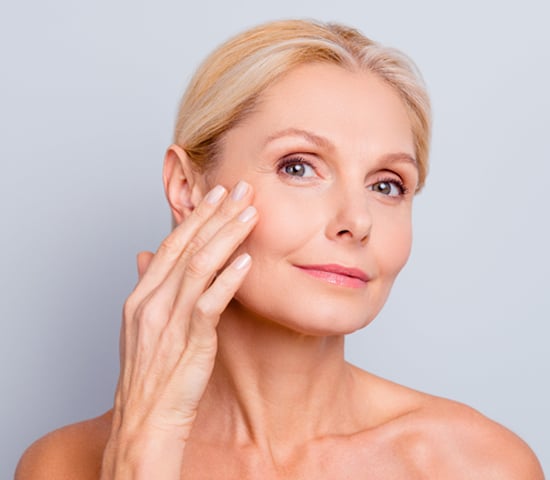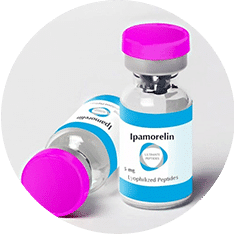
Unlock a More Youthful You With Hormone Replacemment Therapy In Seaport, NY
Aging is inevitable, and for many, it signals the beginning of a new chapter - one where you cross off bucket list items and live life to the fullest, on your own terms. However, for some women, aging is a horrible prospect, filled with chronic fatigue, irritability, and inability to perform in the bedroom. If you're concerned about life in middle age and beyond, we've got great news: there are easy, proven steps that you can take to help stop the negative effect of aging.
Global Life Rejuvenation was founded to give women a new lease on life - one that includes less body fat, fewer mood swings, and more energy as you age. If you're ready to look and feel younger, it's time to consider HRT (hormone replacement therapy), and growth hormone peptides. These therapies for men and women are effective, safe, and customized to fit your goals, so you can keep loving life as you get older.
HRT, and growth hormone peptide therapies bridge the gap between your old life and the more vibrant, happier version of you. With a simple click or call, you can be well on your way to a brighter future. After all, you deserve to be the one in charge of your wellness and health. Now, you have the tools to do so - backed by science and applied by our team of HRT experts with more than 13 years of experience.
What is HRT?
As women age, their hormones begin to go through changes that affect their day-to-day lives. For women, hormone deficiency and imbalance usually occur during menopause and can cause chronic fatigue, hot flashes, and mood swings, among other issues. Hormone replacement therapy helps correct hormone imbalances in women, helping them feel more vibrant and virile as they age.
Often, HRT treatments give patients enhanced quality of life that they didn't think was possible - even in their 60's and beyond.
The benefits for women are numerous and are available today through Global Life Rejuvenation.
HORMONE REPLACEMENT THERAPY
HRT and Anti-Aging Medicine for Women in Seaport, NY
As women age, their bodies begin to go through significant changes that affect their quality of life. This change is called menopause and marks the end of a woman's menstrual cycle and reproduction ability. Though there is no specific age when this change occurs, the average age of menopause onset is 51 years old. However, according to doctors, menopause officially starts 12 months after a woman's final period. During the transition to menopause, women's estrogen and other hormones begin to deplete.
As that happens, many women experience severe symptoms. These symptoms include:
- Hot Flashes
- Chronic Fatigue
- Incontinence
- Trouble Sleeping
- Dryness
- Muscle Loss
- Fat Gain
- Mood Swings
The symptoms of hormone deficiency can be concerning and scary for both women and their spouses. However, if you're getting older and notice some of these symptoms, there is reason to be hopeful. Hormone replacement therapy and anti-aging medicine for women can correct imbalances that happen during menopause. These safe, effective treatments leave you feeling younger, healthier, and more vibrant.


What Causes Menopause?
The most common reason for menopause is the natural decline in a female's reproductive hormones. However, menopause can also result from the following situations:
Oophorectomy: This surgery, which removes a woman's ovaries, causes immediate menopause. Symptoms and signs of menopause in this situation can be severe, as the hormonal changes happen abruptly.
Chemotherapy: Cancer treatments like chemotherapy can induce menopause quickly, causing symptoms to appear shortly after or even during treatment.
Ovarian Insufficiency: Also called premature ovarian failure, this condition is essentially premature menopause. It happens when a woman's ovaries quit functioning before the age of 40 and can stem from genetic factors and disease. Only 1% of women suffer from premature menopause, but HRT can help protect the heart, brain, and bones.
Common Issues for Women During Menopause
For many women, menopause is a trying time that can be filled with many hormonal hurdles to jump through. A little knowledge can go a long way, whether you're going through menopause now or are approaching "that" age.
Here are some of the most common issues that women experience during menopause:

Depression
If you're a woman going through menopause and find that you have become increasingly depressed, you're not alone. It's estimated that 15% of women experience depression to some degree while going through menopause. What many women don't know is that depression can start during perimenopause, or the years leading up to menopause.
Depression can be hard to diagnose, especially during perimenopause and menopause. However, if you notice the following signs, it might be time to speak with a physician:
- Mood Swings
- Inappropriate Guilt
- Chronic Fatigue
- Too Much or Too Little Sleep
- Lack of Interest in Life
- Overwhelming Feelings
Remember, if you're experiencing depression, you're not weak or broken - you're going through a very regular emotional experience. The good news is that with proper treatment from your doctor, depression isn't a death sentence. And with HRT and anti-aging treatment for women, depression could be the catalyst you need to enjoy a new lease on life.

Hot Flashes
Hot flashes - they're one of the most well-known symptoms of menopause. Hot flashes are intense, sudden feelings of heat across a woman's upper body. Some last second, while others last minutes, making them incredibly inconvenient and uncomfortable for most women.
Symptoms of hot flashes include:
- Sudden, Overwhelming Feeling of Heat
- Anxiety
- High Heart Rate
- Headache
- Nausea
- Dizziness
Typically, hot flashes are caused by a lack of estrogen. Low estrogen levels negatively affect a woman's hypothalamus, the part of the brain that controls body temperature and appetite. Low estrogen levels cause the hypothalamus to incorrectly assume the body is too hot, dilating blood vessels to increase blood flow. Luckily, most women don't have to settle for the uncomfortable feelings that hot flashes cause. HRT treatments for women often stabilize hormones, lessening the effects of hot flashes and menopause in general.

Mood Swings
Mood swings are common occurrences for most people - quick shifts from happy to angry and back again, triggered by a specific event. And while many people experience mood swings, they are particularly common for women going through menopause. That's because, during menopause, the female's hormones are often imbalanced. Hormone imbalances and mood swings go hand-in-hand, resulting in frequent mood changes and even symptoms like insomnia.
The rate of production of estrogen, a hormone that fluctuates during menopause, largely determines the rate of production the hormone serotonin, which regulates mood, causing mood swings.
Luckily, HRT and anti-aging treatments in Seaport, NY for women work wonders for mood swings by regulating hormone levels like estrogen. With normal hormone levels, women around the world are now learning that they don't have to settle for mood swings during menopause.

Weight Gain
Staying fit and healthy is hard for anyone living in modern America. However, for women with hormone imbalances during perimenopause or menopause, weight gain is even more serious. Luckily, HRT treatments for women coupled with a physician-led diet can help keep weight in check. But which hormones need to be regulated?
- Estrogen: During menopause, estrogen levels are depleted. As such, the body must search for other sources of estrogen. Because estrogen is stored in fat, your body believes it should increase fat production during menopause. Estrogen also plays a big part in insulin resistance, which can make it even harder to lose weight and keep it off.
- Progesterone: Progesterone levels are also depleted during menopause. Progesterone depletion causes bloating and water retention, while loss of testosterone limits the body's ability to burn calories.
- Ongoing Stress: Stress makes our bodies think that food is hard to come by, putting our bodies in "survival mode". When this happens, cortisol production is altered. When cortisol timing changes, the energy in the bloodstream is diverted toward making fat. With chronic stress, this process repeatedly happens, causing extensive weight gain during menopause.

Low Libido
Lowered sexual desire - three words most men and women hate to hear. Unfortunately, for many women in perimenopausal and menopausal states, it's just a reality of life. Thankfully, today, HRT and anti-aging treatments Seaport, NY can help women maintain a normal, healthy sex drive. But what causes low libido in women, especially as they get older?
The hormones responsible for low libido in women are progesterone, estrogen, and testosterone.
Progesterone production decreases during perimenopause, causing low sex drive in women. Lower progesterone production can also cause chronic fatigue, weight gain, and other symptoms. On the other hand, lower estrogen levels during menopause lead to vaginal dryness and even vaginal atrophy or loss of muscle tension.
Lastly, testosterone plays a role in lowered libido. And while testosterone is often grouped as a male hormone, it contributes to important health and regulatory functionality in women. A woman's testosterone serves to heighten sexual responses and enhances orgasms. When the ovaries are unable to produce sufficient levels of testosterone, it often results in a lowered sex drive.

Vaginal Dryness
Often uncomfortable and even painful, vaginal dryness is a serious problem for sexually active women. However, like hair loss in males, vaginal dryness is very common - almost 50% of women suffer from it during menopause.
Getting older is just a part of life, but that doesn't mean you have to settle for the side effects. HRT and anti-aging treatments for women correct vaginal dryness by re-balancing estrogen, progesterone, and testosterone. When supplemented with diet and healthy living, your vagina's secretions are normalized, causing discomfort to recede.

Fibroids
Uterine fibroids - they're perhaps the least-known symptom of menopause and hormone imbalances in women. That's because these growths on the uterus are often symptom-free. Unfortunately, these growths can be cancerous, presenting a danger for women as they age.
Many women will have fibroids at some point. Because they're symptomless, they're usually found during routine doctor exams. Some women only get one or two, while others may have large clusters of fibroids. Because fibroids are usually caused by hormone imbalances, hysterectomies have been used as a solution, forcing women into early menopause.
Advances in HRT and anti-aging medicine for women give females a safer, non-surgical option without having to experience menopause early. At Global Life Rejuvenation, our expert physicians will implement a customized HRT program to stabilize your hormones and reduce the risk of cancerous fibroid growth.

Endometriosis
Endometriosis symptoms are much like the effects of PMS, and include pelvic pain, fatigue, cramping, and bloating. While doctors aren't entirely sure what causes this painful, uncomfortable condition, most agree that hormones - particularly xenoestrogens - play a factor.
Endometriosis symptoms are much like the effects of PMS and include pelvic pain, fatigue, cramping, and bloating. While doctors aren't entirely sure what causes this painful, uncomfortable condition, most agree that hormones - particularly xenoestrogens - play a factor.
Xenoestrogen is a hormone that is very similar to estrogen. Too much xenoestrogen is thought to stimulate endometrial tissue growth. HRT for women helps balance these hormones and, when used with a custom nutrition program, can provide relief for women across the U.S.
Is HRT for Women the Right Answer?
Hormone stability is imperative for a healthy sex drive and for a normal, stress-free life during menopause. HRT and anti-aging treatments for women balance the hormones that your body has altered due to perimenopause or menopause.
HRT for women is a revolutionary step in helping women live their best lives, even as they grow older. However, at Global Life Rejuvenation, we know that no two patients are the same. That's why we specialize in holistic treatments that utilize HRT, combined with healthy nutrition, supplements, and fitness plans that maximize hormone replacement treatments.
If you've been suffering through menopause, is HRT the answer? That's hard to say without an examination by a trusted physician, but one thing's for sure. When a woman balances her hormone levels, she has a much better shot at living a regular life with limited depression, weight gain, mood swings, and hot flashes.
Here are just a few additional benefits of HRT and anti-aging treatments for females:


Benefits of HRT and Anti-Aging Medicine for Women in Seaport, NY
Hormone imbalance causes a litany of issues. But with anti-aging treatments for women, females can better process calcium, keep their cholesterol levels safe, and maintain a healthy vagina. By replenishing the body's estrogen supply, HRT can relieve symptoms from menopause and protect against osteoporosis. But that's just the start.
Global Life Rejuvenation's patients report many more benefits of HRT and anti-aging medicine for women:
- Fewer Mood Swings
- Thicker Hair
- Stronger Bones
- Less Body Fat
- More Energy
- More Stamina
- Increased Sex Drive and Pleasure Sensations
- Better Cognitive Functions
- Improved Pain Receptors
- Less Hot Flashes and Night Sweats
- Lower Triglycerides
- Fewer Bladder Infections
If you're ready to feel better, look better, and recapture the vitality of your youth, it's time to contact Global Life Rejuvenation. It all starts with an in-depth consultation, where we will determine if HRT and anti-aging treatments for women are right for you. After all, every patient's body and hormone levels are different. Since all our treatment options are personalized, we do not have a single threshold for treatment. Instead, we look at our patient's hormone levels and analyze them on a case-by-case basis.

HRT from Global Life Rejuvenation
At Global Life Rejuvenation, we help women rediscover their youth with HRT treatment for women. We like to think of ourselves as an anti-aging concierge service, guiding and connecting our patients to the most qualified HRT physicians available. With customized HRT treatment plan for women, our patients experience fewer menopausal symptoms, less perimenopause & menopause depression, and often enjoy a more youth-like appearance.
Reverse Aging with Growth Hormone Peptides
Growth hormone peptides are an innovative therapy that boosts the natural human growth hormone production in a person's body. These exciting treatment options help slow down the aging process and give you a chance at restoring your youth.

What is Sermorelin?
Sermorelin is a synthetic hormone peptide, like GHRH, which triggers the release of growth hormones. When used under the care of a qualified physician, Sermorelin can help you lose weight, increase your energy levels, and help you feel much younger.

Benefits of Sermorelin
Human growth hormone (HGH) therapy has been used for years to treat hormone deficiencies. Unlike HGH, which directly replaces declining human growth hormone levels, Sermorelin addresses the underlying cause of decreased HGH, stimulating the pituitary gland naturally. This approach keeps the mechanisms of growth hormone production active.
- Benefits of Sermorelin include:
- Better Immune Function
- Improved Physical Performance
- More Growth Hormone Production
- Less Body Fat
- Build More Lean Muscle
- Better Sleep

What is Ipamorelin?
Ipamorelin helps to release growth hormones in a person's body by mimicking a peptide called ghrelin. Ghrelin is one of three hormones which work together to regulate the growth hormone levels released by the pituitary gland. Because Ipamorelin stimulates the body to produce growth hormone, your body won't stop its natural growth hormone production, which occurs with synthetic HGH.
Ipamorelin causes growth hormone secretion that resembles natural release patterns rather than being constantly elevated from HGH. Because ipamorelin stimulates the natural production of growth hormone, our patients can use this treatment long-term with fewer health risks.

Benefits of Ipamorelin
One of the biggest benefits of Ipamorelin is that it provides significant short and long-term benefits in age management therapies. Ipamorelin can boost a patient's overall health, wellbeing, and outlook on life.
When there is an increased concentration of growth hormone by the pituitary gland, there are positive benefits to the body. Some benefits include:
- Powerful Anti-Aging Properties
- More Muscle Mass
- Less Unsightly Body Fat
- Deep, Restful Sleep
- Increased Athletic Performance
- More Energy
- Less Recovery Time for Training Sessions and Injuries
- Enhanced Overall Wellness and Health
- No Significant Increase in Cortisol
Your New, Youthful Lease on Life with HRT for Women
Whether you are considering our HRT and anti-aging treatments for women in Seaport, NY, we are here to help. The first step to reclaiming your life begins by contacting Global Life Rejuvenation. Our friendly, knowledgeable HRT experts can help answer your questions and walk you through our procedures. From there, we'll figure out which treatments are right for you. Before you know it, you'll be well on your way to looking and feeling better than you have in years!
 866-793-9933
866-793-9933
Request a Consultation
Latest News in Seaport, NY
Seaport Residences Remains Indefinitely Stalled at 161 Maiden Lane in Financial District, Manhattan
Michael Young and Matt Pruznickhttps://newyorkyimby.com/2023/11/seaport-residences-remains-indefinitely-stalled-at-161-maiden-lane-in-financial-district-manhattan.html
Leading off our Turkey Week rundown of prominent stalled projects in New York City is Seaport Residences, a 60-story residential skyscraper at 161 Maiden Lane along the border of Lower Manhattan’s Financial District and the South Street Sea...
Leading off our Turkey Week rundown of prominent stalled projects in New York City is Seaport Residences, a 60-story residential skyscraper at 161 Maiden Lane along the border of Lower Manhattan’s Financial District and the South Street Seaport District. Designed by Hill West Architects and developed by Fortis Property Group, the slender 670-foot-tall tower, originally dubbed One Seaport, was planned to span 200,000 square feet and yield 80 condominium units with interiors by Groves & Co. Ray Builders was the last general contractor to work on the beleaguered project, which stands on a narrow site bound by South Street and Maiden Lane, directly across from the FDR Drive and the East River.
The skyscraper has languished with no progress for the last three years, and there are no indications of work resuming anytime soon. After breaking ground nearly a decade ago, the project famously unraveled in early 2019 over reports that the reinforced concrete superstructure was leaning three inches to the north, leading to a public spat between Fortis and the original contractor, Pizzarotti LLC. Despite its lean, the structure was deemed safe and curtain wall installation resumed later that year under the supervision of a new contractor, Ray Builders, but by our update in September of 2020, significant portions of the glass envelope had been removed for unclear reasons.
Today, the superstructure looms as a forlorn skeleton over the East River waterfront, its future in doubt.
Fortis Property Group originally acquired the property for $64 million was anticipating a sellout of $272 million on the condominium units. It remains unclear if and when work on Seaport Residences will resume.
Subscribe to YIMBY’s daily e-mail
Follow YIMBYgram for real-time photo updates Like YIMBY on Facebook Follow YIMBY’s Twitter for the latest in YIMBYnews
Permits have been filed for a six-story residential building at 1152 Lafayette Avenue in Bushwick, Brooklyn. Located between Broadway and Bushwick Avenue, the interior lot is near the Knickerbocker Avenue subway station, serviced by the M train. Richard Zavlyanov of Diamond Development Group is listed as the owner behind the applications.
The proposed 60-foot-tall development will yield 10,483 square feet designated for residential space. The building will have ten residences, most likely condos based on the average unit scope of 1,048 square feet. The masonry-based structure will also have a cellar and a 32-foot-long rear yard.
Robert Bianchini of ARC Architecture + Design Studio is listed as the architect of record.
Demolition permits have not been filed yet. An estimated completion date has not been announced.
Subscribe to YIMBY’s daily e-mail
Follow YIMBYgram for real-time photo updates Like YIMBY on Facebook Follow YIMBY’s Twitter for the latest in YIMBYnews
Spanish multinational financial services company BBVA has announced plans to relocate its headquarters to Two Manhattan West, a recently completed 58-story office skyscraper in the Manhattan West complex in Midtown West. The move is set to be finalized by the end of 2024.
BBVA’s new headquarters is set to occupy roughly 74,000 square feet across two floors in Two Manhattan West. The skyscraper offers modern amenities, including fitness centers, conference facilities, and outdoor terraces, and is strategically located near major transportation hubs and city attractions.
A key aspect of BBVA’s move is the alignment with its sustainability goals. Two Manhattan West, designed by Skidmore, Owings & Merrill, is LEED-Gold certified and powered entirely by renewable energy, specifically run-of-river hydropower. This eco-friendly approach is in line with Brookfield Properties‘ commitment to transitioning its U.S. office portfolio to zero-emissions electricity by 2026.
With BBVA on board, Two Manhattan West has now achieved over 80 percent occupancy, joining other major tenants in the area and demonstrating the building’s appeal to leading global firms.
Subscribe to YIMBY’s daily e-mail
Follow YIMBYgram for real-time photo updates Like YIMBY on Facebook Follow YIMBY’s Twitter for the latest in YIMBYnews
South Street Seaport Museum Announces free February Book Club event: Here is New York by E. B. White
Divya Sarmahttps://patch.com/new-york/upper-east-side-nyc/calendar/event/20240226/ddeb49db-6887-4d75-8c9b-d69cfc555656/south-street-seaport-museum-announces-free-february-book-club-event-here-is-new-york-by-e-b-white
South Street Seaport Museum announces the February selection of the Seaport Museum Book Club is Here is New York by E. B. White. The free event will be held on February 26, 2024, at 6:30pm at McNally Jackson Seaport, 4 Fulton Street. ...
South Street Seaport Museum announces the February selection of the Seaport Museum Book Club is Here is New York by E. B. White. The free event will be held on February 26, 2024, at 6:30pm at McNally Jackson Seaport, 4 Fulton Street. seaportmuseum.org/bookclub
In honor of the season of love, the Seaport Museum Book Club invites you to delve into the heartwarming selection, Here is New York. This timeless piece by E. B. White serves as the quintessential love letter to New York City, capturing its essence with perceptive, humorous, and nostalgic insights during a stroll around Manhattan in 1948.
Join this lively discussion on White’s masterful work, and rediscover your affection for the city. Recognized by The New York Times as one of the ten best books ever written about the metropolis, and hailed by The New Yorker as “the wittiest essay, and one of the most perceptive, ever done on the city,” this publication promises to rekindle your love affair with the vibrant and ever-evolving cityscape. Don’t miss the chance to share your thoughts and reflections on this literary gem with fellow enthusiasts. You don’t have to read the full essay to enjoy the event––everyone is welcome!
Here is New York is available for purchase at most bookstores. Register for the January meeting of the Seaport Museum Book Club today to receive a 10% off discount code for online orders of the book at McNally Jackson Books. mcnallyjackson.com/book/9781892145024
About the South Street Seaport Museum
The South Street Seaport Museum, located in the heart of the historic seaport district in New York City, preserves and interprets the history of New York as a great port city. Founded in 1967, the Museum houses an extensive collection of works of art and artifacts, a maritime reference library, exhibition galleries and education spaces, working 19th century print shops, and an active fleet of historic vessels that all work to tell the story of “Where New York Begins.” seaportmuseum.org
#
#SouthStreetSeaportMuseum #WhereNewYorkBegins
Sea Creatures From the Deep, Captured in Glass, Rise at Mystic Seaport
Meredith Mendelsohnhttps://www.nytimes.com/2023/11/18/arts/design/glass-artisans-mystic-connecticut.html
An enterprising father and son in Dresden, Germany, Leopold and Rudolf Blaschka, found success in the 19th century hand-blowing glass models of marine invertebrates and selling them to universities and natural history museums around the world, from New England to Tokyo. Harvard and ...
An enterprising father and son in Dresden, Germany, Leopold and Rudolf Blaschka, found success in the 19th century hand-blowing glass models of marine invertebrates and selling them to universities and natural history museums around the world, from New England to Tokyo. Harvard and Cornell bought around a thousand, in total, by mail order in the 1870s and 1880s.
As it turns out, many of those same types of invertebrates were also traveling the world — and they still are, transported by maritime traffic, clinging to the hulls of ships and riding in their ballasts. Some of those native European creatures, modeled in glass long before terms like invasive species and biofouling were coined, are now thriving in Stonington Harbor in the Mystic River Estuary, off the coast of Connecticut.
Those well-traveled species are the inspiration behind “Spineless: A Glass Menagerie of Blaschka Marine Invertebrates” at the Mystic Seaport Museum nearby, through Sept. 2024. Included in the rare loan of more than 40 delicate Blaschka models, mostly from Harvard’s Museum of Comparative Zoology, are several whose pesky counterparts are blanketing nearby docks and pilings.
It’s the first time that the Blaschka models have been given so much historical context, from 19th-century sailors’ journals and jars of preserved specimen to zoological illustrations that informed the Blaschkas. The museum even included a few related contemporary art works.
“It’s a way for us to authentically talk about ocean health within our mission and within our site,” Christina Brophy, senior vice president of curatorial affairs at the Mystic Seaport Museum, said while sitting out on one of its sunny decks last month. The largest maritime museum in the United States, it’s better known for whaling vessels than ecological research. But one of the show’s curators, James T. Carlton, director emeritus of the Williams-Mystic Coastal & Ocean Studies Program of Williams College and the Mystic museum, has been scraping ship hulls since 1982 and cataloging his findings to record the area’s changing biodiversity.
The Blaschka glass models are fragile and rarely travel. But the museum was able to secure a wide variety, including sea anemones, octopuses, squids, tube worms and sea squirts.
“We were looking for species that had both a local story and a global story, species that have been spread around the world by ships for centuries,” said Carlton, who collaborated with the museum’s curator of collections, Krystal Rose.
In an era before scuba diving, underwater cameras, or mass-produced textbooks, the Blaschkas’ lifelike sea creatures were the gold standard of marine zoology teaching models. Invertebrates could not be taxidermied, and collected specimen lose their color and form when preserved in jars, as we can see from the many on view here, including some dating to the 19th century.
Leopold (1822—95) and Rudolf (1857–1939) offered around 700 marine invertebrate species, which they sold through catalogs like Ward’s Natural Science Establishment of Rochester, N.Y. Created by the process of lampworking — glass blowing using an open flame — and then painstakingly hand-painted, the models were designed to look more realistic than beautiful. But they are works of art, with their multiple layers of glass and fine frills, fringes, suckers and tentacles. (They rarely appear on the market but a Portuguese man o’war brought around $13,000, and a jellyfish, around $20,000, at a Christie’s London auction in 2019.)
“They were a more or less accurate rendering of the species,” said James Hanken, a professor in Harvard’s Museum of Comparative Zoology, who spearheaded the cleaning, restoration, and display of that institution’s 434 Blaschka models in the early 2000s, after finding them stored away in dusty boxes.
“The Blaschkas were very, very, specific about their parts,” said Elizabeth Brill, a glassworker and marine biology field technician who restored Harvard’s collection (and Cornell’s before that). “They knew exactly how long each tentacle should be, from one species of jellyfish to the next.” Brill restored the one jellyfish on view, which is missing some of its fragile tentacles (replicated by the Blaschkas by coating wires in glass).
Leopold, who hailed from Bohemian glassworkers, started out making jewelry and then glass eyeballs both for humans and taxidermy. He also made stunning glass flowers, producing more than 4,000 with his son for Harvard. What’s surprising is that these two artists in landlocked Dresden could have replicated marine species so accurately.
Leopold did in fact glimpse live jellyfish in all their glass-like luminosity years before he started making them, while sailing across the Atlantic to the U.S. in the early 1850s. By the late 1870s he and his son had acquired a seawater aquarium and ordered live animals that came wrapped in seaweed from marine stations throughout Europe. (Much of what we know of them comes from their archives at the Corning Museum of Glass.)
Zoological illustrations were also essential. Early on, Leopold emulated drawings of anemones by Philip Henry Gosse, the Victorian naturalist and collector of marine species known as the inventor of the modern aquarium (and for trying to reconcile his creationist beliefs with his scientific findings). Later, the Blaschkas borrowed illustrations from Ernst Haeckel, a German zoologist and skilled artist who cataloged many of the thousands of marine species pulled up by the HMS Challenger, a British ship that spent three and a half years, starting in 1872, gathering data from the ocean’s depths.
“There was so much documentation of marine invertebrates in the 19th century,” Rose said. “Citizen scientists were walking the shores noticing these things.”
This escalating fascination with the sea helped fuel the Blaschkas’ success, “along with Darwin’s publication of the ‘Origin of Species’ and explorations going to all kinds of places,” Hanken said.
With those explorations, of course, came marine creatures as invasive as the humans leading them.
The exhibition includes several models of invasive sea squirts, or tunicates, named for the leathery tunic-like sheath that protects their soft bodies. They tend to grow in clusters and create a slimy blanket that can befoul aquaculture and create drag on ship hulls. And then there are the living ecosystems they disturb.
“We generally don’t like to see invaders,” Carlton told me while watching recent video footage of some of the sea squirts swaying in the tidal surge in nearby Stonington Harbor, where they blanket docks and pilings. “They could replace or displace a native species. And it might have a cascade effect.” The most visible, lightbulb sea squirts, named for their translucent white tubelike forms that seem to glow, are native to Europe but were discovered in Long Island Sound in the early 2000s. The Blaschkas’ version is encased nearby and shows three colorless glass tubes sprouting from a base, each filled with tiny glass coils that seem like precursors of fluorescent light bulbs.
The Blaschkas’ models brought attention to the ocean’s changing biodiversity when a Cornell professor, Drew Harvell, set off on a scuba diving journey in 2013 to see how many live versions of the Blaschkas’ models she could locate. Coral reefs damaged by pollution, blast fishing and ocean warming were among her finds. A book and film documented the project.
Warming waters are also enabling nonnative species to survive where they previously could not, Carlton said. What we can do, as individuals, he said, is “try to clean as well as possible whatever we’re moving or transporting” that might have associated species tagging along.
Once again, “our eyes on the shore are citizen scientists,”Rose said, pulling up an app on her phone, inaturalist, a nonprofit organization that’s building a crowdsourced database detailing where and when living things appear. “Anyone can report a species sighting, and then it gets confirmed by others,” she said. Carlton added, “one step ahead of science.”
Port of New York and New Jersey moves the most TEUs since October 2022
Lori Ann LaRoccohttps://www.freightwaves.com/news/port-of-new-york-and-new-jersey-moves-the-most-teus-since-october-2022
Peak season for the Port of New York and New Jersey has arrived. Not only did the port take the top spot for containers moved in July, but it was the port’s highest monthly total since October 2022. A total of 725,479 TEUs were processed in July.Rick Cotton, Port Authority executive director, tells American Shipper it was extremely gratifying to see the strong performance that made the port the busiest in the nation for July.“The Port of New York and New Jersey’s strong performance in July as the peak shipping...
Peak season for the Port of New York and New Jersey has arrived. Not only did the port take the top spot for containers moved in July, but it was the port’s highest monthly total since October 2022. A total of 725,479 TEUs were processed in July.
Rick Cotton, Port Authority executive director, tells American Shipper it was extremely gratifying to see the strong performance that made the port the busiest in the nation for July.
“The Port of New York and New Jersey’s strong performance in July as the peak shipping season gets underway underscores our business partners’ confidence in the East Coast’s biggest port to move their goods quickly and reliably,” Cotton said. “Our deep relationships and collaboration with all links of the regional supply chain continue to reap tangible benefits for our stakeholders who have retained their business here in New York-New Jersey even as the impact of softening global trade is felt elsewhere.”
Based on current port data compiled by American Shipper, the East Coast and Gulf ports are strongly favored over West Coast ports. The Port of Los Angeles announced a drop of 26% in twenty-foot equivalent units processed year over year in July. Compared to June, there was a drop of 148,744 TEUs processed in July. The ports of Savannah, Georgia, and Houston both recorded increases over the same time frame. The Port of Houston was up year over year with its July container processing.
New York and New Jersey Port officials tells American Shipper they saw a 40% increase in shipments of apparel, toys, games and sporting equipment. The port also moved 9.4% more cargo this July compared to July 2019.
The strength of trade arriving at the Port of New York and New Jersey and the Gulf and East Coast ports continues to flow through the Panama Canal despite the current congestion. The Panama Canal is a critical trade link for U.S. shippers heading to Gulf and East Coast ports.
The Panama Canal Authority (ACP) tells American Shipper, “The Canal continues to be the preferred route for the container carrier segment which has been minimally impacted by the adjustments to draft and transits associated with the measures to conserve water.”
“New York/New Jersey, Savannah and Houston are the most important ports in the U.S. Gulf/East Coast, accounting for almost 60% of total imports, and moving 70% of Eastern Asia imports in July 2023,” the ACP added. “Currently, all of the 18 liner services deployed in the Asia — U.S. Gulf/East Coast route via Panama Canal call at either New York/New Jersey, Savannah or Houston. The Panama Canal has maintained a strong participation in this trade lane — with vessels capacity up to 16,000 TEU — because of the value offered in terms of connectivity, distance, and time”.
Even water conservation measures that have increased wait times upwards of two weeks for some vessels to pass are not dissuading shippers from using the preferred water route.
The ACP added, “Vessels that book in advance, such as containerships, are transiting as scheduled through the Panama Canal, without significant delays.”
The U.S. is the largest user of the Panama Canal, with total U.S. commodity export and import containers representing about 73% of Panama Canal traffic. Forty percent of all U.S. container traffic travels through the canal every year, about $270 billion in cargo. U.S. energy and agriculture also use this waterway to transfer goods.
David Chang’s Momofuku Ssäm Bar Is Closing
Melissa McCarthttps://ny.eater.com/2023/9/8/23864855/momofuku-ssam-bar-closing-david-chang-seaport-nyc
In 2021, David Chang decided to move his hugely popular Momofuku Ssäm Bar to the Seaport, a neighborhood in transition — one associated with tourists, finance, and the absence of Fulton Fish Market following its 180-year tenure. Two years later, the restaurant has announced on Instagram that it is closing at the end of the month. The last day of service is September 30.“We will ...
In 2021, David Chang decided to move his hugely popular Momofuku Ssäm Bar to the Seaport, a neighborhood in transition — one associated with tourists, finance, and the absence of Fulton Fish Market following its 180-year tenure. Two years later, the restaurant has announced on Instagram that it is closing at the end of the month. The last day of service is September 30.
“We will always be grateful for the teams past and present who made Ssäm Bar such a special restaurant over the past 17 years,” reads the Instagram announcement, citing its roots in the creation of the global brand, Momofuku. “It is hard to overstate the impact Ssäm Bar had on Momofuku and beyond.” Eater has contacted Momofuku for more information on the closure.
Ssäm Bar relocated to the Seaport after 15 years in the East Village. The restaurant’s lease was expiring; instead of renewing it, the team moved the restaurant into a space that was home to another Momofuku restaurant, Bar Wayō, which opened at the Seaport in 2019. The move was announced early in the pandemic in tandem with the closing of the Korean Italian restaurant Nishi, open since 2016.
When Ssäm Bar opened in April 2021, the new location felt like “a monogrammed polo shirt of its formerly raffish self,” Eater critic Ryan Sutton wrote of the move. While the menu and space saw many iterations over the years, in the most recent one, “the group has managed to keep its creative culinary soul intact, slinging gelatinous raw crab platters, Korean-Lebanese wrap sandwiches, and buttery imitation crab rolls in places where one might otherwise expect a $70 strip steak.”
Momofuku Ssäm Bar opened in 2006 in the East Village at 207 Second Avenue, near East 13th Street, two years after the debut of the scrappy Momofuku Noodle Bar, a restaurant that was huge in shaping how New Yorkers dined. This, too, became a quintessential restaurant, despite its ever-changing menu that helped drive New Yorkers’ quest for new menu items from old favorite restaurants.
Two years after it opened, the New York Times called Ssäm Bar “the cornerstone of the Chang legend,” wrote then-critic Frank Bruni. “It justly enshrined Mr. Chang as a chef who went further than any of his peers in wedding serious, sometimes challenging food and an ultra-casual, spontaneous dining ethos in tune with unbound times.”
The move to the Seaport tracked with an infusion of money into the Momofuku brand in 2016, marking a shift from opening in a residential neighborhood to billion-dollar developments like Columbus Circle, Hudson Yards, and the Seaport’s Pier 17.
After the restaurant closes, Momofuku will be down to three restaurants in New York City: Noodle Bar, Ko, and the fast-casual, made-for-the-mall Bāng Bar, which opened in Time Warner Center in 2018. There’s also a Momofuku in Las Vegas and Majordomo in Los Angeles.
Disclaimer:


